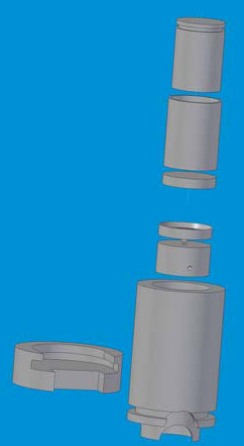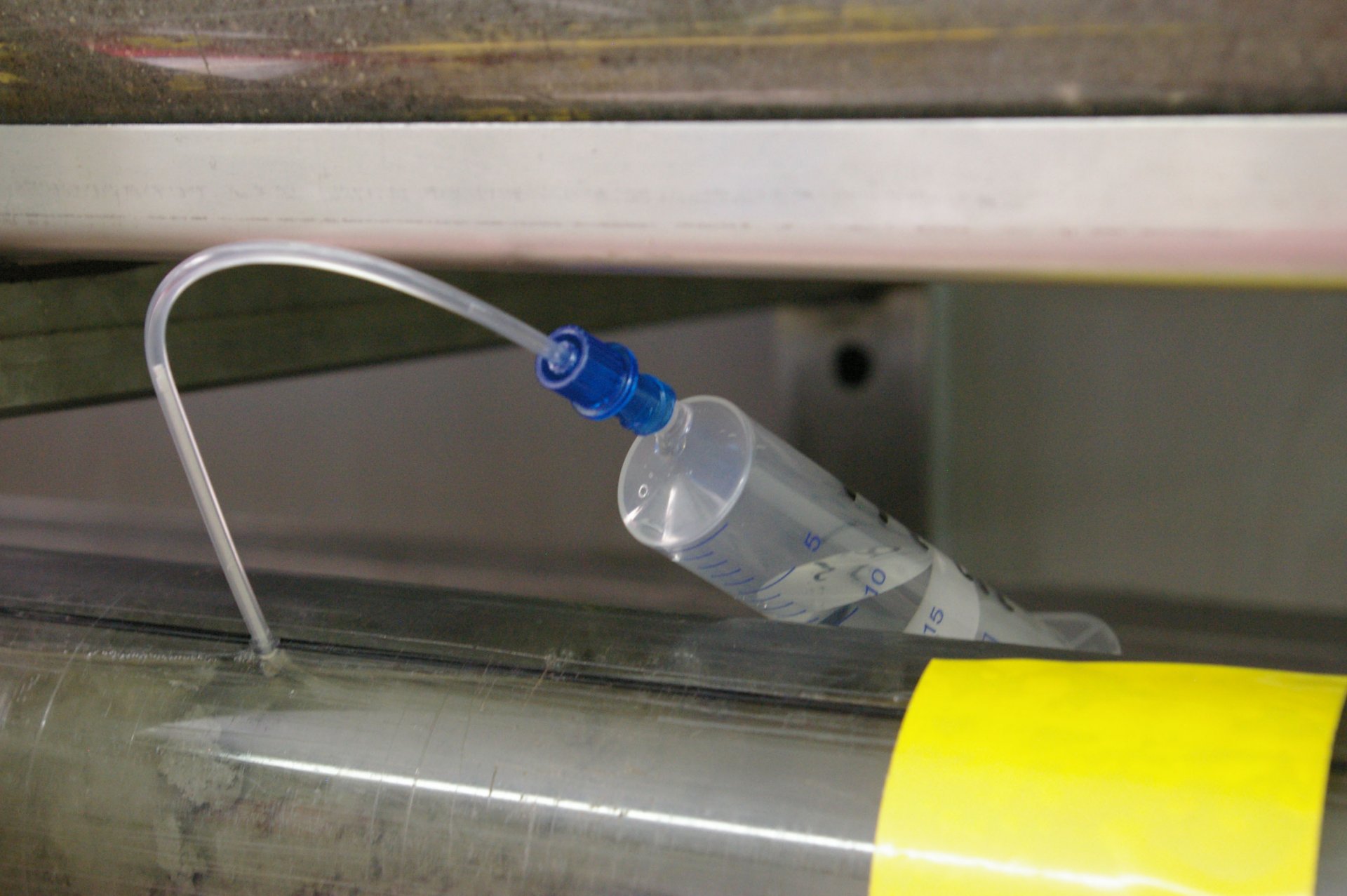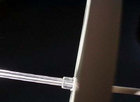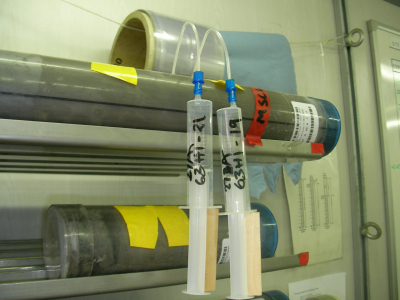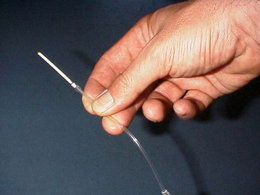Acquisition
In addition to pore water squeezers, pore-water acquisition with the new generation of “Rhizone pore water samplers” will be used on MSP expeditions in the less indurated parts of the records. They have been proven to be an excellent technique that saves core sample material.
Rhizone samplers are 2.5 mm in diameter and 5 cm in length; they can be inserted into the sediment from the cut face of core segments, or alternatively through tiny holes drilled into the liner. The samples are collected in either 10 mL vacuum tubes designed for medical use or disposable syringes requiring a minimum of experience and maintenance.
Rhizone pore water samplers
If time and the type of sediment allows, pore water samplers called rhizones will be used (Seeberg et al., 2005). Rhizones consist of a microporous tube that is supported by a nylon or PEEK wire and connected to PVC tubing terminated with a male Luer lock connector, so it can be easily attached to needles or syringes. Rhizones are simply pushed into the wet sediment and vacuum is attached to the connecting tube by vacutube, syringe or a peristaltic pump. The microporous tube has a pore width of 0.1 µm such that additional filtering is not necessary.
Preparation
Quick: Use one of the blue female-female Luer adapters to connect a rhizone to a disposable syringe. Immerse the rhizone in a beaker of pure water and force some uL of water in and out by slowly pulling and pushing the plunger.
Slow: immerse the microporous (white) tube end in a beaker of pure water for 30 min. Once the microporous tube is wet, it is not permeable for air anymore.
Placing rhizones in the sediment
Loose wet sediment: put the sediment in a beaker. If necessary use a 2 mm plastic wire (or HPLC PEEK tubing) to preform a channel and push the rhizone gently into the sediment from above by firmly holding the wire in the clear PVC tubing rear part of the sampler.
The tip of the nylon wire is glued to the tip of the microporous tube. This way the sensitive microporous tube is pulled in from the tip rather than pushed in. For best performance the microporous tube should be covered with wet sediment completely. Yet, it still works if only part of it has contact with pore water.
Sediment core: carefully drill a 3.8 mm hole in the liner at the depth of interest (or in the liner cap). Make sure to avoid contaminating the sediment with the tip of the drill. If necessary preform a channel with a plastic wire. Gently push the rhizone in all the way to the connector between microporous tube and PVC tubing. This connector tubing should seal the 3.8 mm hole.
Disconnect the light blue protective cap and attach vacuum to the luer connector. The rhizones have very low dead volume. Discard the first 0.5 mL of sample.
Metal free sampling: Use one of the blue female-female Luer adapters to connect a rhizone to a disposable syringe. Slowly pull the plunger – if the microporous tube is wettened correctly it will keep the vacuum - and fix it with a wooden spacer provided with the blue luer adapters. Discard the first 0.5 mL and reassemble. Wait. If necessary repeat.
Vacuum is applied after the rhizone is placed in the sediment and kept by a wooden spacer.
Sampling with vacutubes: Connect a Luer needle to the rhizone sampler and push the needle through the rubber stopper of a plain vacutube. Use a separate vacutube to collect the first 0.5 mL . Attach the sample vacutube. Wait! One vacutube will ideally sample up to 8 mL of water. If necessary attach additional vacutubes.
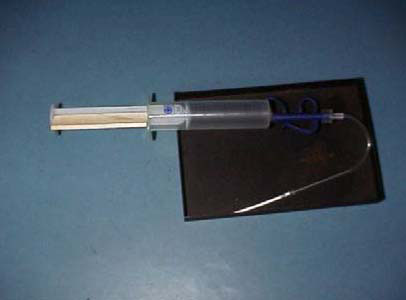
Cleaning
All syringes vacutubes adaptors and rhizones are meant to be used one way. Yet, if necessary the rhizones may be cleaned and reused. Gently clean the rhizones mechanically from the outside and wash with some water. Inspect the microporous tube for damages. Force some 10 mL dilute nitric acid through the microporous tube from the inside using a syringe. Force some pure water in and out for three times using a syringe.
Change water between steps. If vacuum is attached while the rhizone is wettened but NOT in contact with water, it should keep the vacuum. If not it is likely to be damaged.
References
- Dickens, G.R., Koelling, M., Smith, D.C., Schnieders, L. and the IODP Expedition 302 Scientists Party (2007): Rhizon Sampling of Pore Waters on Scientific Drilling Expeditions: An Example from the IODP Expedition 302 (ACEX).- Scientific Drilling 4: 22-25, doi:10.2204/iodp.sd.4.08.2007
- Seeberg-Elverfeldt, J., M. Schlüter, T. Feseker, and M. Kölling, (2005): Rhizon sampling of pore waters near the sediment/water interface of aquatic systems, Limnology and oceanography: Methods, 3, 361-371.
- Expedition 310 Scientists (2007). Methods. In: Camoin, G.F., Iryu, Y., McInroy, D.B., and the Expedition 310 Scientists. Proc. IODP, 310: Washington, DC (Integrated Ocean Drilling Program Management International, Inc.) doi:10.2204/iodp.proc.310.103.2007
- Expedition 302 Scientists (2006). Methods. In: Backman, J., Moran, K., McInroy, D.B., Mayer, L.A., and the Expedition 302 Scientists. Proc. IODP, 302: College Station TX (Integrated Ocean Drilling Program Management International, Inc.) doi:10.2204/iodp.proc.302.103.2006
Pore water squeezer
Mobile hydraulic press with manual pressure control
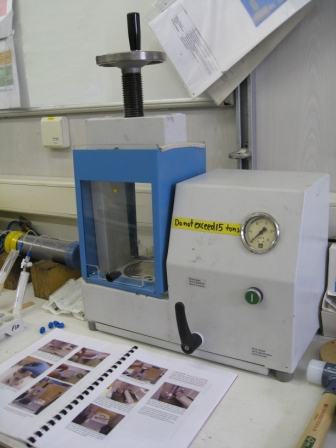
Scheme: outer squeezing assemblage (interior in pink)
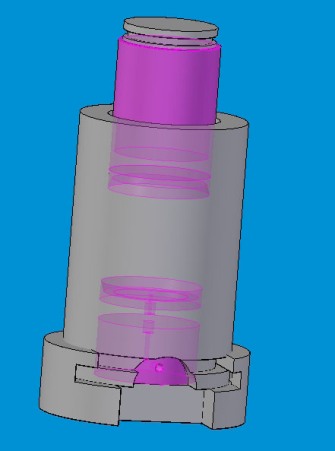
Detail: press with squeezing assemblage and parts
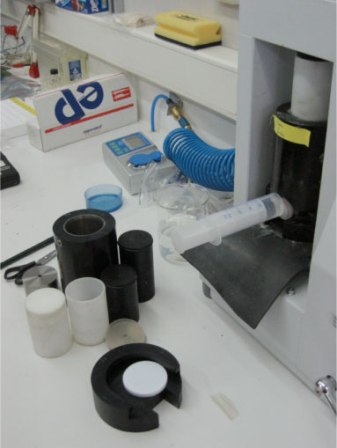
Scheme: inner squeezing assemblage in detail
